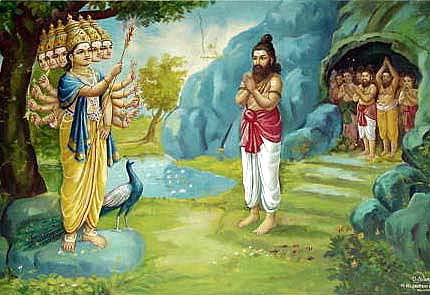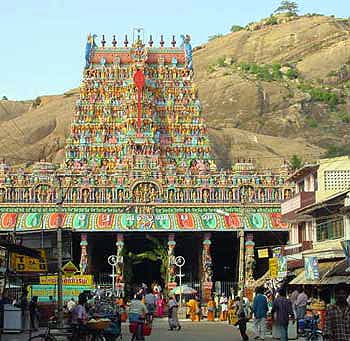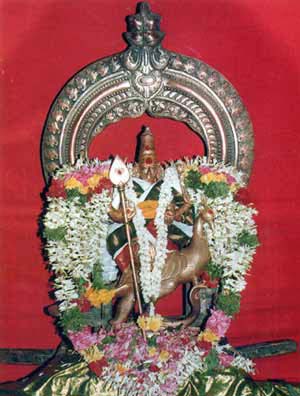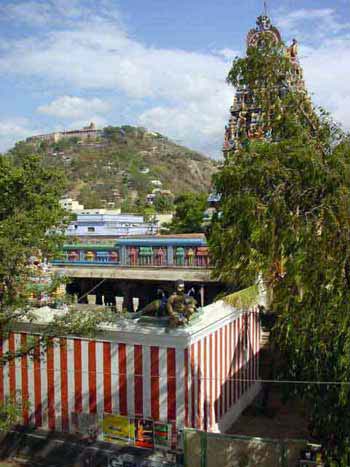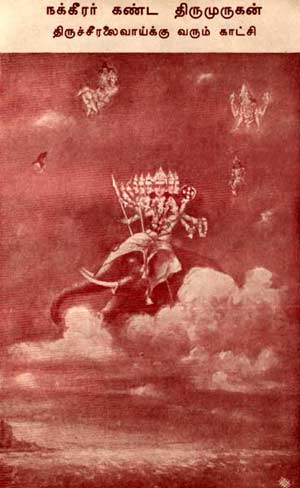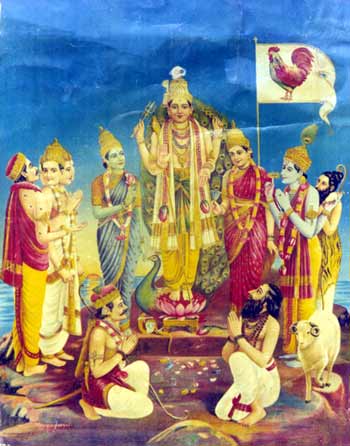
|
|||||||||||||||
|
| |||||||||||||||
Distinctive features of Tirumurukārruppatai
by Ponnaih Jeyaalaki ArunagirinathanTirumurukārruppatai remains as one of the most important works of Cankam works. It is counted among the Pattuppattu and was composed by Nakkirar. As it belongs to the later Cankam period, it must have been written between the 3rd and 4th Century A.D (1). During the early Cankam period bards and poets would go from court to court, sing to the king, praise him and receive some recompense. There are references in Puranānuru, one of the anthologies belonging to the Cankam period, in which one bard tells another whom he meets on the road that one should visit a king to become rich. Such a poem ‘recommendation on the road' is termed ārruppatai. Seeming in the same category Tirumurukārruppatai or ‘Guide to Lord Muruku' suggests that those who need spiritual guidance should go to the god Murukan. This was possibly the first main anthology-poem which points out the Murukan worship of the time and the anthology-poem is in praise if Murukan shows the antiquity of the actual worship. In order to see how distinctive Tirumurukārruppatai is, it is important to deal with the concepts such as the main themes of the poem, different stages in the evolution of Murukan worship, the superiority of the cult of Murukan, his six armories will be analyzed in this article. In addition to this, the religious and social customs during the time of Tirumurukārruppatai, the mythologies it deals with, the similes and the landscape descriptions and finally how this work bridges both Brahminical and Dravidian cultures are also will be dealt in the following lines. Tirumurukārruppatai has been written in the metre called ciriyappa (2) and is 317 lines long. The subject matter starts with an account of the splendor of Murukan. It follows with a graphic description of the celestial damsels dancing and singing around the Lord. . This beautiful scene immediately follows by a most revolting account of a demoness and her dancing while the Lord cuts down the asura: Curapatman. The beautiful scenes of the splendid city of Madurai have superseded these descriptions and then the poem moves to the hilly abodes of Ārupataivitu: the six armories (3). It seems the intention of the poet is now motivating the devotees towards the feet of Murukan. He begins the next stanzas by saying if they wish to obtain salvation, they should visit these holy shrines: the Ārupataivitu. At this point the poem begins with the most wonderful descriptions of Tiruparankunram: one of the shrines of Ārupataivitu which situated in an admirable landscape (4). Then the poet guides the devotees to another shrine called Tiruciralaivay where the Lord mounted on an elephant and marches for a conquest as Devasenāpati: 'The captain general of the celestial army'. This incident is being described very artistically and this section is also deals with the detailed narration of the six faces and twelve arms of the Skanda, as well as their functions performed by them (5).
After these accounts, another shrine, Tiruvavinankuti is being examined. Its been said that the Lord spends some days with his consort Teyvayanai and is being visited by the three great gods: Siva, Vishnu and Indra. Nakkirar describes that the ascetics of the higher order and the Gandharvas, the celestial musicians along with their women, accompany these gods. There are other minor gods and the exalted ones also visited Murukan at Tiruvavinankuti. Nakkirar also gives an elaborate illustration of these three great gods: Visnu with his Garuda flag, Siva the three eyed Lord with his spouse Uma who is the left of his body and the Indra, the handsome god with his thousand eyes who achieved merit by performing a thousand sacrifices. All these gods came along with their entourage to plead with Skanda on behalf of Brahma – who was banished to the earth by the Skanda for some wrongful act (6). The poet immediately takes the devotees to another grand journey towards Tiruverakam – the house of the twice-born Brahmans (7) who observe their religious duties and their daily rituals with great discipline. After this, the poet walks the devotees through the hilly regions – Kurinci, which is the habitation of the tribal people, or the Kuravas. Here the tribal women are dressed in leaf and flower garments. The Lord dances with these tribal maids. His embracing troubles the Kurinci maids of these hilly tracts. All the maids fall in love with Murukan and to get rid of these love-struck maids' pains the tribal people celebrate a kind of ritual ceremony called Veriyattu. The tribal priestess is performing this ritual and Murukan accepts their offering made out of a non-vegetarian dish (8). (It is interesting to note how Saiva myths ‘appropriates' Krishna myths: cp. This is the gopis and Anayanayanar with Gopala!) Finally it seems the right time for Nakkirar to advise the devotees to achieve moksha or salvation by approaching the Lord's feet. In the concluding part of Tirumurukārruppatai the poet also tells about some waterfalls and rivers where the Lord said to be manifests himself. In order to see how Tirumurukārruppatai differ from the other works, it is also important to see the different stages in the evolution of Murukan worship. We shall examine the types of worship that are mentioned in Tirumurukārruppatai in chronological order. Firstly Skanda is being worshipped by the celestial beings. Secondly he is worshipped by the demons – asuras. Then the great gods and the twice-born Brahmans are worshipping him. Finally the tribal people lovingly worship him and then the worship is opened to all. Here Nakkirar tries to pinpoint different stages of bhakti and implies that Skanda as a Vedic god is worshipped by the supernatural beings and the beings of higher esteem. He is also a local god; Murukan who is adorned by the tribal people and so forth. Here one could notice both the Brahminical / Northern and Dravidian elements mingling together. In this way the poet achieves a task of bridging both traditions in a harmonious way in this anthology – poem. When analyzing the chronology of Murukan worship in the light of bhakti, Murukan has been pointed out as a patron of tribal people. At this stage he is commonly addressed as Velan ‘spearman' and also a non-vegetarian god. In the second stage of the evolution of bhakti, the shrines or the six armories are mentioned. When this Brahminical temple worship is established, from tribal to temple worship is also traced and the devotion is consolidated amongst the devotees. By painting a picture that Muurkan is accessible for all hierarchy, eventually the author classifies his motivation of advising the devotees by saying if they want to achieve moksha they should go to these particular shrines and worship Murukan. Furthermore, when analyzing the Tirumurukārruppatai's distinctive nature it is also essential to look at the superior qualities of the Lord of this anthology – poem. In the first account Murukan is referred by many names: The husband of both Teyvayanai and Valli, the red god; Cevvel, the child of six mothers, the teacher who preaches the meanings of Pranava mantra or the mystical formula – Aum – to his father, the son of the god who sits under the banyan tree, the child of Koravai, the commander in chief for the heavenly armies, god of the hills and the god of Kurinci. It has been said the name Murukan itself means a beautiful and eternal youth. Skanda has been praised as Devasenāpati, the commander in chief of the Devas' army and also respected reverently by the three great gods. As pointed out earlier, this poem is a fine example for joining the Aryan and Dravidian gods. Brahminical deities are wisely incorporated in the poem and created the entire pantheon of Tirumurukārruppatai. In the descriptions of Tiruparankunram Murukan is accompanied by a demoness and dances a kind of dance called Tunankai in the Southern manner. When he describes Tiruciralaivay Nakkirar portrays Murukan with six faces and twelve arms. This is purely a northern conception of Kārttikeya, the war god and the son of Siva. In Tiruvavinankuti when the great gods visiting the Skanda he includes Indra the Vedic god and other minor gods whom plead for another puranic god Brahma. In the section of Tiruverakam the poet points out the Brahmans who too are northerners. In Kunrutoratal the accounts of tribal people have been described in the Dravidian manner. Both traditions are included in this poem cleverly and carefully which shows that the poet has had an intention of popularizing Murukan bhakti for both traditions. He tries harder to familiarize Skanda amongst all classes and make people feel proud of their own traditions. Moreover by talking about Arupataivitu or the six armories the poet never failed to point out the landscape and their antiquity. By giving importance to those shrines he emphasizes that these are the most important shrines chosen by the Lord himself to perform his divine feats. He also makes people of the different landscape feel much more proud about themselves as they are closed to their deity. Unlike most other Cankam works Tirumurukārruppatai is essentially a religious poem. It is also one of the most important works of the Eleventh Tirumurai of the Saivas. It is the daily liturgy of the devotees of Murukan. Its religious significance is illustrated in the lines 95-101 and 407-416 of Tirumurukārruppatai. Nakkirar advises that in order to achieve salvation, one has to attach to the feet of the Lord and detach himself from all the worldly pleasures. If one remains lovingly meditating the Lord's feet, Murukan will receive his wish with love and kindness and grant him moksha. Here the Siddhanta philosophy has been summarized to give the religious significance to the poems.
From the elaborate descriptions in the poems, it becomes easier to analyze the religious and social customs of Tamil Nadu in the late Cankam period. Firstly the rites and ceremonies are clearly evident amongst the tribal people. Ceremonies performed show the religious life of the tribal people. Murukan is their patron, and to honor him, the priestess raises the cock banner, rubs ghee and mustard to the banner chants, offers flowers; wears two garments and winds a red thread around her wrist she also offers millet mixed with ram's blood sprinkles perfumes and burns incense. Finally she sings Kurinci tunes and dances to the accompaniments of various instruments. When reading these, the reader immediately gets a feel of Southern traditions. In the same manner, Northern customs and rites are also depicted in this anthology – poem. People who are good at their penance are portrayed with matted locks and clothe themselves in deerskins and barks of trees. They also live their life according to eminent moral standard and piety. During the time of Tirumurukārruppatai the temple worship has been established and Brahmans made their way towards Tamil Nadu already. We also have accounts of their way of life, which are said to be their performances of the six duties prescribed for their caste, their bachelorhood and the religious duties are also described. Besides the tribal and Brahminical traditions, there appears a village tradition in the poem. Village life and the scenes are portrayed in detail. The poet's reference to kantu literally means a stick remains on of the most important accounts to picture the local religious traditions of those days. Kantu can be described as a branch of a tree cut and planted for the deity to reside in (9). This became the origin of later religious images. Reference to a place called manram: this means that a hall appears in the poem. This is also an important word, which tells the village way of living. Mandram is probably a place where the elders of the village carried out the village administration. Later these were used as rest houses for strangers and also used to carry our religious rituals. All these references are testimonies for the kind of life styles existed at the time of Tirumurukārruppatai. There are imagery or similes used elaborately. For instance similes such as flowers in ponds are like eyes, the skin of women resembles mango shoots and their beauty spots are like streaks of gold on a touchstone and so forth, but these are common to all Cankam poems. They help us to understand the poet's poetical talent or his mere imagination. Moreover, the beautiful descriptions of the landscape, including mountains, waterfalls, riverine and field flora and fauna, help us to imagine the land's wealth and the peaceful lifestyle of that particular time. The way in which the poet includes mythology is also gives a very distinctive approach to Tirumurukārruppatai. From one or two lines the poet tries to tell the very different mythologies. If one is familiar with this type of religious mythology they can be highly appreciated. Mythologies such as ‘the Birth of Skanda' (Kumārasambhavam) (10), the death of Curapatman' (11) ‘the story of the four towered city of Madurai or Nanmatakkutal' (12) ‘the destruction of the three cities' (13) ‘Murukan's curse on Brahma' (14) and ‘Murukan's victory over Tarakan' (15) are some of them. In conclusion, Tirumurukārruppatai is one of the Cankam works and due to its importance to Skanda bhakti it is included in the Eleventh Tirumurai. It is interesting to note that from the following periods of its peak Siva and Vaishnava bhakti in Tamil Nadu supersede the Murukan bhakti. From the 5th Century onwards Nayanmar and then Alvars popularized Siva and Vaishnava bhakti. The compiler of Tirumurai, Nampiyantar Nampi, must have been observed Tirumurukārruppatai's distinctive nature and the important message it relates. Thus he must have included this in the Eleventh Tirumurai as one of the significant works. From this period onwards, Tirumurukārruppatai became one of the most important liturgy of the Tamils and remains intact. End Notes
Bibliography
Jeyālaki Arunagirinathan can be contacted at: JArunagirinathan@tower.ac.uk.See also these related resources: |
|
|
